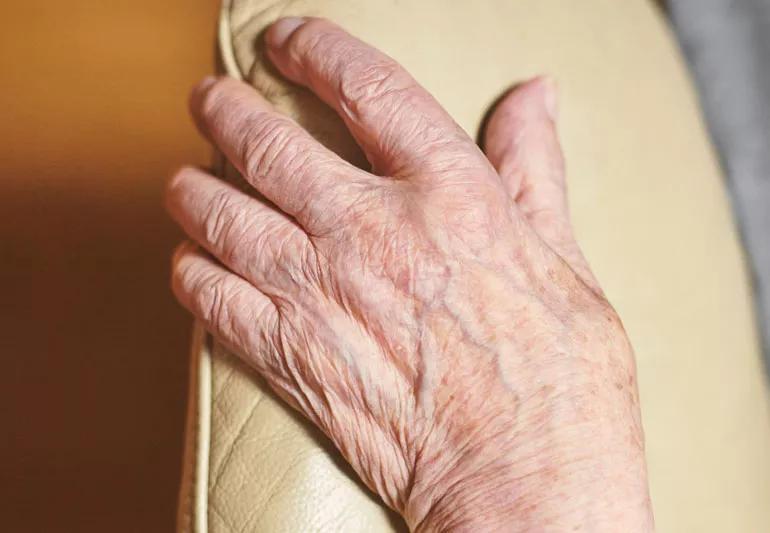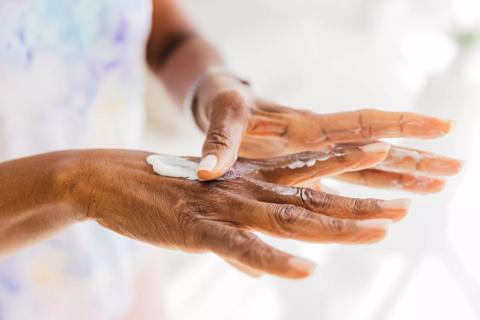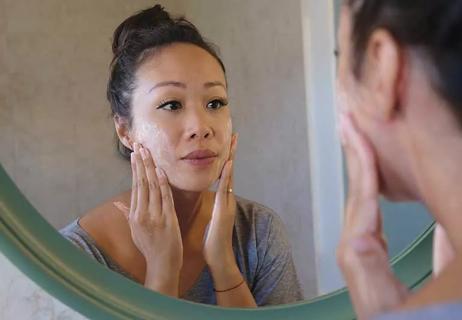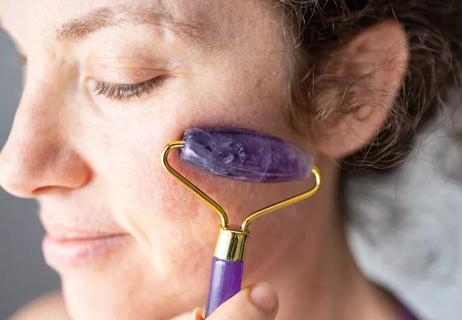Advertisement
Topical treatments and even some cosmetic procedures may help reduce the appearance of fine lines and wrinkles

If the eyes are the windows of the soul, then skin is the window to our age.
Advertisement
Cleveland Clinic is a non-profit academic medical center. Advertising on our site helps support our mission. We do not endorse non-Cleveland Clinic products or services. Policy
And as we grow older, our skin can gradually become looser and more flaccid (and we have plenty of ways to combat the signs of aging).
But when skin begins to feel thin as paper, or like crepe, age isn’t the only cause.
Unlike wrinkles around the eyes and mouth (that result from repeated muscle movements), crepey skin typically can be traced to sun damage. Over time, exposure to the sun and its harmful UV rays breaks down elastin, the fibers in your skin that allow it to stretch and return to its normal position.
Those fibers can heal, but they eventually lose their ability to repair completely after repeated exposure over time. Think of it as an elastic waistband that, with wear, becomes more lax.
Dermatologist Amy Kassouf, MD, explains what causes crepey skin, how you can prevent crepey skin and what kind of treatments are available.
What is crepey skin? When your skin becomes thin and develops wrinkles or fine lines, it can have a crepe paper-like appearance, hence the phrase “crepey skin.” You’ll most commonly see crepey skin under your eyes and on your arms. So what causes crepey skin?
Common reasons include:
If you’re into your 40s or beyond, your skin no longer produces oils the way it did when you were younger. These oils act as a barrier, protecting skin from chemicals in the environment that cause irritation and inflammation.
“Crepey skin usually begins to appear when you’re in your 40s. But it can show up as early as your 20s if you are a chronic tanning bed user or have gained and lost substantial amounts of weight,” says Dr. Kassouf. “Medications are another potential cause of crepey skin, such as long-term prednisone.”
Other factors may include alcohol use, smoking, lack of sleep, pollution and stress.
Luckily, there are ways to prevent crepey skin. Dr. Kassouf share what you can do at home.
The most important thing to do, says Dr. Kassouf is to stay out of the sun as much as possible. Also, protect your skin when you’re in the sun. That means wearing sunscreen every day and opting for sun-protective clothing when outside.
So how do you choose the best sunscreen for you?
Dr. Kassouf says look for one that’s at least SPF 30. Ideally SPF 50 or higher helps insure you’re covered even when you don’t apply a thick enough layer. It should also be broad spectrum, covering UVA as well as UVB rays.
Keeping skin well-hydrated with a good moisturizer helps prevent injury that creates or worsens crepiness.
When it comes to what kind of lotion for crepey skin you should use?
Look for moisturizers that contain lubricating and plumping ingredients like alpha or beta hydroxy acids (like salicylic acid, lactic acid or glycolic acid) ― or one that has a high concentration of hyaluronic acid, known for holding onto moisture.
Advertisement
Should you take supplements or vitamins for crepey skin?
Dr. Kassouf says to focus on a diet high in antioxidants — think plenty of fruits and vegetables, as well as foods like eggs, tuna and brown rice — which can play a role in your skin health.
A well-balanced diet is also full of vitamins such as vitamin A, C, D and E and omega-3 fatty acids, all which can contribute to your overall skin appearance.
“Many products contain B vitamins and other antioxidants and now plant-based adaptogens to help decrease inflammation and allow restoration of collagen and elastin fibers,” says Dr. Kassouf.
Already noticing crepey skin and wondering how to get rid of crepey skin? You may want to consider these following treatment options.
Adding emollients and hydroxy acid cleansers to your skin care routine not only helps keep your skin from becoming crepey, but it also helps prevent further damage if your skin is already lax.
Dr. Kassouf recommends retinol topical creams to help reduce that crepey look. Retinols help restore skin’s elasticity and thicken collagen (which gives our skin its structure) as well as elastin (which gives our skin its stretch).
“When starting a treatment that includes retinol, there’s often a phase that seems drier and flakier before the skin starts to feel better,” explains Dr. Kassouf. “This is temporary and part of the increasing turnover of the older damaged skin cells.”
Dermal fillers can be used to plump dry skin, smooth out lines and wrinkles and restore volume. A dermatologist injects the fillers just under your skin — and results can last months. Some are meant for specific lines and contours and others are more generally volumizing.
And there are several types of fillers, many of which contain hyaluronic acid and other biostimulators such as poly-L-lactic acid (PLLA) that can help your body lay down new collagen. Your healthcare provider will determine which type is best for you and your skin.
Advertisement
A kind of laser resurfacing, fractionated lasers create microscopic holes in the skin (think aerating the lawn). These holes contract as they heal and grow fresh, new skin at the surface. This evens out your tone and texture on your face, or even on thicker skin areas elsewhere.
“Fractionated lasers can be used to improve the quality of the skin but has also been shown to decrease skin cancer risk and treat scarring and other skin conditions,” says Dr. Kassouf.
This noninvasive procedure uses a high-intensity focused ultrasound (HIFU) to penetrate deep tissue layers, which stimulates new collagen growth.
The procedure, which is done in-office by a healthcare provider, can be used on your neck, eyebrow, chin and decolletage.
Also known as fat freezing or CoolSculpting®, this nonsurgical body contouring procedure removes stubborn fat by exposing your skin to very cold temperatures.
You typically won’t see results for a few months as the idea is that over time the targeted fat cells will permanently die.
“Cryolipolysis is really meant to remove small pockets of otherwise hard-to-address fatty areas — and isn’t used typically to help with crepey skin,” says Dr. Kassouf.
You may want to consider procedures that uses radio frequency waves to heat skin, build collagen and tighten up in a limited area.
This procedure is sometimes painful and costly, and there are slight risks, Dr. Kassouf says. It has variable success rates and isn’t meant for everyone, she says.
The best candidate for this kind of procedure is someone who:
Moisturizers and other creams work well for mildly crepey skin, but they have limitations. For instance, if you’ve lost a large amount of weight, leaving you with a lot of crepey skin, a plastic surgeon likely will need to remove it.
Your dermatologist may suggest an elective cosmetic surgery such as:
“Unfortunately, any time you have surgery you will have a scar,” warns Dr. Kassouf. “Most plastic surgeons are very good at hiding those scars but you may want to get more than one opinion before moving forward.”
When it comes to crepey skin remedies, there are a host of options available — from lotions to surgery — that can help reduce crepey skin as you age. Some products are available over the counter and some need a prescription.
Work with your doctor or dermatologist to decide what the best options are for your lifestyle and skin care needs.
Advertisement
Learn more about our editorial process.
Advertisement

To help keep your mitts feeling and looking their best, moisturize, exfoliate, wear sunscreen and eat a healthy diet

With repeat injections over time, you may be able to slow the development of new wrinkles

The cosmetic injection may help train your muscles out of frowning, but there’s no hard data to say for sure

Day creams should protect your skin, night creams should soothe and repair it

Not necessarily, but reading labels can help you avoid allergen-containing ingredients

Keep it simple: Stick with a gentle cleanser, vitamin C, retinol, moisturizer and sunscreen

The treatment triggers collagen production by using your own blood

A face roller can provide a temporary boost to your appearance

Your metabolism may torch 1,300 to 2,000 calories daily with no activity

A gentle touch in all the right places may help drain your sinuses